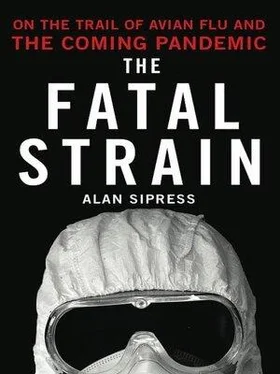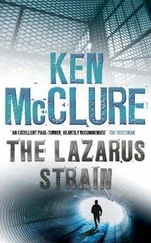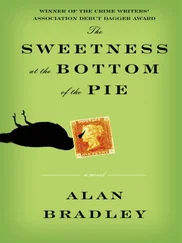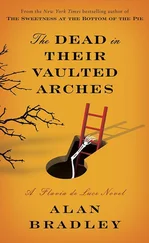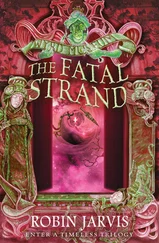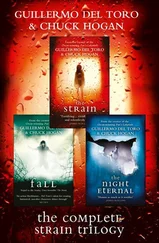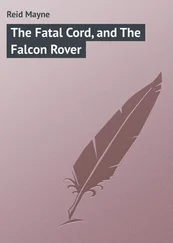That figure is so big as to be incomprehensible. Researchers would rather dwell on scenarios more akin to 1918. That strain claimed fewer than five percent of those it infected. If the coming pandemic follows suit, the global death toll would only be 62 million, according to one extrapolation.
The World Bank originally projected that a severe pandemic could cost the world economy $800 billion in the initial twelve months. By late 2008, the World Bank had nearly quadrupled this estimate, concluding that an epidemic would cost about $3.13 trillion during the first year. Even a mild pandemic, like the 1968 Hong Kong flu, would cost $450 billion, and a moderate one like the 1957 Asian flu would reach $1.3 trillion.
The gloom was suffocating in those final weeks of 1997, like the cold, foul mist wrapping Hong Kong’s steep slopes and settling on its myriad islands. A small, tongue-shaped islet called Ap Lei Chau had become the latest focus of the city’s collective anxiety.
Five-year-old Chan Man-kei had been playing with friends at her kindergarten, a brightly decorated school on the ground floor of a public housing project in Ap Lei Chau, when she started throwing up. Her parents had been called. A doctor had referred her to nearby Queen Mary Hospital, where her lab samples tested positive for bird flu. About a week later, on Tuesday, December 16, Hong Kong health officials announced that two of her younger cousins had also been hospitalized in Queen Mary’s isolation ward. They, too, might have the virus.
Hours after that disclosure, Fukuda and Chan addressed the press about the heightened prospect of human transmission. “It’s a possibility in this case and one of the things we are concerned about,” Fukuda acknowledged at the evening news conference. Chan agreed that Man-kei might have infected her cousins. “They live together at Grandma’s and play together,” she said. The health department was trying to crack the case, she told reporters, assuring them, “We are working at breakneck pace.”
Ap Lei Chau was connected to the southern shore of Hong Kong island by a bridge. A decade earlier, the government had erected several dozen brown-and-gray high-rise apartment buildings on the green hillsides of Ap Lei Chau, and about ninety thousand people now lived there, making it one of the most densely populated islands on Earth. Man-kei’s two younger cousins and a third sibling stayed with their parents and grandparents in an apartment barely three hundred square feet in size. This was often where Man-kei spent her days.
When health investigators arrived at the apartment, they were rebuffed. The family patriarch, a sixty-four-year-old watchman, refused to speak with them or provide blood samples to see if he’d been exposed to the virus. Other family members were also reluctant to talk. They were afraid of being stigmatized or shunned by neighbors spooked by this new, mysterious plague. Fukuda arranged to meet one relative secretly at a café, the first of several clandestine interviews health officers conducted over the course of the outbreak. Eventually, they were able to tease out a history of the children’s recent activities, noting what they had done together and what they’d done separately. (Only one of the younger cousins ultimately tested positive for the virus. All three children survived.) But the source of their infection remained elusive.
Chan was frustrated. She couldn’t visit Ap Lei Chau herself because of the media frenzy this would cause. Nor was she getting a good sense of the family and its surroundings from the investigators. She kept sending them back to scare up more details, instructing them to observe the neighborhood at different times of day and different days of the week.
“I want to know exactly what is going on,” she insisted. “What do the children do?”
“They play in the car park,” came the response. “That’s their play-ground.”
Chan wanted to be able to picture the parking lot. She told them to take photographs and draw her a map. They did. Nothing seemed amiss.
But when the team returned to Ap Lei Chau the following Sunday, they spied cages of geese in the parking lot at the base of the apartment tower. There were several stalls near the entrance. Perhaps they’d been there on previous occasions and the children had passed too close. The investigators snapped some photographs and later presented them to Chan. They were all thinking the same thing.
Samples were taken from the grubby cages and tested. “Bingo,” Tsang recalled. “We found a positive swab in one of the stalls.”
They had identified a likely source for the infection. But could it account for both Man-kei and her cousin? Or had Man-kei caught the virus and then passed it to her cousin while they were frolicking on their grandmother’s carpet? Could the virus already be spreading from one person to another? Neither Chan nor Fukuda nor anyone else could ever rule that out.
Hong Kong at Christmas was a city under siege. People were flooding emergency rooms to be tested for the virus. Even medical personnel were calling in sick, fearful they’d been infected. Drug prices had spiked, and panicked calls were overwhelming the health department’s hotlines. Though only a handful of sick chickens had been discovered in the city’s live markets, poultry sales had plummeted, and restaurants were banishing popular Cantonese chicken delicacies from their menus. On Christmas Eve alone, three more suspected human cases had been announced. Now the first of the seasonal flu cases were also surfacing.
There was no holiday break that year for the six members of the CDC team. Fukuda had never before missed a Christmas with his wife and daughters. So the health department arranged a Christmas Day lunch cruise for their CDC guests. But they couldn’t escape the oppressive mood. Word came that four more suspected cases had been identified, the highest one-day total so far.
“I don’t know whether this disease will stop or spread,” Fukuda once again told reporters two days later. He was appearing at a press conference on Saturday, December 27, with Chan and Hong Kong’s agriculture chief, Lessie Wei. There were now about twenty confirmed or suspected cases. The press was demanding to know what more the government would do to stem the crisis. Since poultry were thought to be responsible for most of the outbreaks, would officials have them killed? Chicken hawkers had already been ordered to clean and disinfect their cages. On Christmas Eve, Hong Kong had barred all imports of chicken from mainland China, the primary source of the city’s poultry and a possible origin of the infection. “I feel at this point in time,” Chan responded, “the measures are sufficient.”
The call that changed everything came that night at two in the morning on Sunday, December 28. Chan was at home in bed. It was the agriculture department. There had been a die-off of chickens at Cheung Sha Wan, the city’s main wholesale poultry market. About fifty birds from a batch of three hundred in a single stall had abruptly fallen over dead with swollen chests and necks, internal bleeding, and other symptoms of avian flu. And there was more bad news. A week earlier, a similar outbreak had occurred at a farm in the New Territories. The disease had moved gradually along a row of cages, claiming its victims. The test results had just come back positive for bird flu.
Chan couldn’t fall back asleep. “What is going on?” she wondered. Only days before, city inspectors had toured Hong Kong’s farms and reported that there were no outbreaks. “Margaret,” she told herself, “the size of the problem is bigger than what it appears.”
She didn’t have proof of a widespread poultry outbreak. But if there was one, it could finally explain the unrelenting series of human cases. She thought about the holding pens, nicknamed “chicken hotels,” where Hong Kong’s birds were kept overnight. As demand for poultry had dropped, retailers in the city’s live markets found they couldn’t sell many of their chickens. At the end of each day, birds from various stalls and markets were gathered together before being distributed again for sale in the morning. Chan’s technical advisors had told her this system was perfect for disseminating disease throughout the markets. “Enough is enough,” she thought.
Читать дальше
